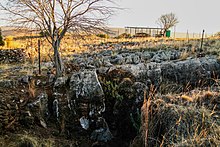Kromdraai fossil site
| Kromdraai Fossil Site, Cradle of Humankind | |
|---|---|
| Location | Gauteng, South Africa |
| Nearest city | Krugersdorp, South Africa |
| Established | Incorporated into the Cradle of Humankind 1999 |
| Governing body | Cradle of Humankind and Private Landowner |
Kromdraai is a fossil-bearing breccia filled cave located about 2 km east of the well known South African hominid-bearing site of Sterkfontein and about 45 km Northwest of the City of Johannesburg, South Africa. It is situated within the Cradle of Humankind World Heritage Site and is itself a South African National Heritage Site.[1]
History of investigations


In 1938, the site was brought to the attention of Robert Broom by a local schoolboy named Gert Terrblanche who had discovered several hominin teeth. The teeth formed part of a skull that would become the holotype of Paranthropus robustus. Broom began excavations at the site that would continue until approximately 1947 and would result in the discovery of numerous hominin remains. Two deposits were noted and named at the site — Kromdraai A and Kromdraai B — the latter being the site where the hominin remains were recovered.[2]
In 1955 C.K. Brain recommenced work at Kromdraai B and discovered numerous additional hominin remains as well as abundant non-hominin fauna.[3]
In the 1980s Elizabeth Vrba briefly conducted excavations at Kromdraai B in order to recover additional samples for her work on South African bovids.[4]
In 1993 excavations were re-opened by Francis Thackeray of the Transvaal Museum and Lee Berger of the University of the Witwatersrand. They were later joined by teams from Harvard University and other collaborators.[5] Important results of this work have been the recovery of additional hominin fossils as well as the obtaining of more accurate dates for the site.
Recovered fossils
Besides the holotype specimen of P. robustus, at the time of the writing of this article 29 hominin specimens had been recovered from Kromdraai B.[3] Many thousands of animal fossils have also been recovered from both Kromdraai A and B.
Age of the deposits
Kromdraai B is dated to between approximately 2.0 - 1.6 Ma with the majority if not all the Paranthropus robustus fossils dating to between 1.8 and 1.6 Ma.[6]
See also
References
- ^ "9/2/233/0022-001 - Kromdraai Palaeontological Reserve, Kromdraai 71, Krugersdorp District". South African Heritage Resources Agency. Retrieved 16 September 2013.
- ^ R. Broom (1950). Finding the Missing Link. Watts, London.
{{cite book}}: Cite has empty unknown parameter:|coauthors=(help) - ^ a b J.F. Thackeray, D.J. de Ruiter, L.R. Berger and N.J. van der Merve (2001). Hominid fossils from Kromdraai: a revised list of specimens discovered since 1938. Annals of the Transvaal Museum 38. pp. 43–56.
{{cite book}}: Cite has empty unknown parameter:|coauthors=(help)CS1 maint: multiple names: authors list (link) - ^ E. Vrba (1981). The Kromdraai Australopithecine site revisited in 1980: recent investigations and results. Annals of the Transvaal Museum. pp. 17–60.
{{cite book}}: Cite has empty unknown parameter:|coauthors=(help) - ^ L.R. Berger, C. Menter and F. Thackeray (1994). The renewal of excavation activities at Kromdraai, South Africa. South African Journal of Science. pp. 209–210.
{{cite book}}: Cite has empty unknown parameter:|coauthors=(help) - ^ Herries, A.I.R., Hopley, P.J., Adams, J.W., Curnoe, D., Maslin, M.A. 2010. Letter to the editor: Geochronology and palaeoenvironments of Southern African hominin-bearing localities-A reply to Wrangham et al., 2009. "shallow-water habitats as sources of fallback foods for hominins" .

